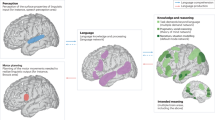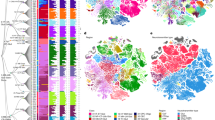Abstract
Cortical complexity, a measure that quantifies the spatial frequency of gyrification and fissuration of the brain surface, has not been thoroughly characterized with respect to gender differences in the human brain. Using a new three-dimensional (3D) analytic technique with magnetic resonance imaging, we found greater gyrification in women than men in frontal and parietal regions. Increased complexity implies more cortical surface area, which may offset gender differences in brain volume and account for behavioral gender differences.
This is a preview of subscription content, access via your institution
Access options
Subscribe to this journal
Receive 12 print issues and online access
$209.00 per year
only $17.42 per issue
Buy this article
- Purchase on Springer Link
- Instant access to full article PDF
Prices may be subject to local taxes which are calculated during checkout

Similar content being viewed by others
References
Rabinowicz, T. et al. J. Neuropathol. Exp. Neurol. 61, 46–57 (2002).
Witelson, S.F., Glezer, I.I. & Kigar, D.L. J. Neurosci. 15, 3418–3428 (1995).
Gur, R.C. et al. J. Neurosci. 19, 4065–4072 (1999).
Van Essen, D.C. Nature 385, 313–318 (1997).
Sled, J.G., Zijdenbos, A.P. & Evans, A.C. IEEE Trans. Med. Imaging 17, 87–97 (1998).
Woods, R.P., Grafton, S.T., Watson, J.D., Sicotte, N.L. & Mazziotta, J.C. J. Comput. Assist. Tomogr. 22, 153–165 (1998).
MacDonald, D., Avis, D. & Evans, A. Proc. Int. Soc. Opt. Eng. 2359, 160–169 (1994).
Sowell, E.R. et al. Cereb. Cortex 12, 17–26 (2002).
Thompson, P.M., Woods, R.P., Mega, M.S. & Toga, A.W. Hum. Brain Mapp. 9, 81–92 (2000).
Thompson, P.M., Schwartz, C., Lin, R.T., Khan, A.A. & Toga, A.W. J. Neurosci. 16, 4261–4274 (1996).
Nopoulos, P., Flaum, M., O'Leary, D. & Andreasen, N.C. Psychiatry Res. 98, 1–13 (2000).
Zilles, K., Armstrong, E., Schleicher, A. & Kretschmann, H.J. Anat. Embryol. (Berl.) 179, 173–179 (1988).
Roland, P.E. & Zilles, K. Trends Neurosci. 17, 458–467 (1994).
Caviness, V.S. Science 189, 18–21 (1975).
Cohen, J. Statistical Power Analysis for the Behavioral Sciences pp. 25–27 (Hillsdale, New York, 1988).
Acknowledgements
This work was supported by Deutsche Forschungsgemeinschaft (DFG, JA 737/8-1), research grants from the National Library of Medicine and National Institute on Aging (R01 LM05639), National Institute of Mental Health and National Institute of Neurological Disorders and Stroke (P20 MH065166), resource grants from the National Center for Research Resources (P41 RR013642 & M01 RR000865), an NIMH NRSA Training Grant (MH14584) and NARSAD Young Investigator Award (to K.L.N.), and R21 grants RR19771 and EB01561 (to P.T.). Additional support was provided by the National Institute of Biomedical Imaging and Bioengineering, National Institute of Neurological Disorders and Stroke, and National Institute of Mental Health (P01 EB001955).
Author information
Authors and Affiliations
Corresponding author
Ethics declarations
Competing interests
The authors declare no competing financial interests.
Supplementary information
Supplementary Figure 1
Calculating cortical complexity. In our analyses (1) ordered hierarchies of parametric meshes with variable resolutions were generated for each lobar region of interest, as shown here for the right superior-frontal region. (2) Subsequently, the logarithmic least squares regression of the measured surface area was plotted against the logarithm of the spatial frequency of the mesh. This dependence of the area measurement on the spatial resolution of the parametric grid is often termed the 'fractal dimension' and reflects the rate at which the measured surface area increases as the spatial detail in the surface representation is increased. For example, the area measured for a flat surface would always be the same at different spatial frequencies; the area of a convoluted surface will increase with increasing spatial resolution. (3) Finally, the slope of the regression plot was derived and added to the number 2, resulting in complexity values between 2 (for a planar or flat surface) and 3 (for a surface with immense numbers of convolutions and extensive folding). Although the slope of the regression plot would provide an equally useful complexity measure, adding the number 2 results in fractal dimension values that agree with the true physical dimension of the surface in the case of a 2D plane (where the fractal dimension turns out to be 2), and a surface that fills all of 3D space (where it is 3). (GIF 53 kb)
Rights and permissions
About this article
Cite this article
Luders, E., Narr, K., Thompson, P. et al. Gender differences in cortical complexity. Nat Neurosci 7, 799–800 (2004). https://doi.org/10.1038/nn1277
Received:
Accepted:
Published:
Issue Date:
DOI: https://doi.org/10.1038/nn1277
This article is cited by
-
An MRI Study of Morphology, Asymmetry, and Sex Differences of Inferior Precentral Sulcus
Brain Topography (2024)
-
Multivariate multiscale entropy (mMSE) as a tool for understanding the resting-state EEG signal dynamics: the spatial distribution and sex/gender-related differences
Behavioral and Brain Functions (2023)
-
Sex differences of signal complexity at resting-state functional magnetic resonance imaging and their associations with the estrogen-signaling pathway in the brain
Cognitive Neurodynamics (2023)
-
Cingulate cortex morphology impacts on neurofunctional activity and behavioral performance in interference tasks
Scientific Reports (2022)
-
Sexual dimorphism in the relationship between brain complexity, volume and general intelligence (g): a cross-cohort study
Scientific Reports (2022)



